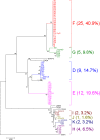Chlamydia trachomatis isolated from cervicovaginal samples in Sapporo, Japan, reveals the circulation of genetically diverse strains
- PMID: 31948401
- PMCID: PMC6966806
- DOI: 10.1186/s12879-020-4780-y
Chlamydia trachomatis isolated from cervicovaginal samples in Sapporo, Japan, reveals the circulation of genetically diverse strains
Abstract
Background: This study was conducted to understand the molecular epidemiology of circulating Chlamydia trachomatis (Ct) strains in Sapporo, Japan.
Methods: A total of 713 endocervical samples collected from April 2016 to March 2019 were screened for Ct. The obtained Ct positive samples were analyzed by ompA genotyping and multilocus sequence analysis (MLSA).
Results: Eighty-three (11.6%) samples were positive for Ct plasmid DNA. Sequence analysis of the ompA gene from the 61 positive cases revealed eight genotypes: F (40.9%), E (19.6%), D (14.7%), G (9.8%), H (6.5%), I (3.2%), K (3.2%), and J (1.6%). The globally dominant genotype E and F strains were highly conserved with 13 ompA genetic variants being detected, whereas genotype D strains were the most diverse. Genetic characterization of D strains revealed that D1 genetic variants may be potentially specific to Sapporo. MLSA revealed 13 unique sequence types (STs) including four novel STs from 53 positive samples, with the globally dominant STs 39 and 19 being predominant. STs 39, 34, and 21 were exclusively associated with genotypes E and F indicating their global dominance. Novel ST70 and ST30 were specifically associated with genotype D.
Conclusion: Our study has revealed the circulation of genetically diverse Ct strains in the women population of Sapporo, Japan. We suggest identifying a transmission network of those successful strains and implementing public health prevention strategies to control the spread of Ct in Sapporo.
Keywords: Chlamydia trachomatis; Genotypes; Multilocus sequence analysis; ompA.
Conflict of interest statement
The authors declare that they have no competing interests.
Figures



Similar articles
-
Multilocus sequence typing of genital Chlamydia trachomatis in Norway reveals multiple new sequence types and a large genetic diversity.PLoS One. 2012;7(3):e34452. doi: 10.1371/journal.pone.0034452. Epub 2012 Mar 28. PLoS One. 2012. PMID: 22470572 Free PMC article.
-
Prevalence of Chlamydia trachomatis Genotypes in Men Who Have Sex with Men and Men Who Have Sex with Women Using Multilocus VNTR Analysis-ompA Typing in Guangzhou, China.PLoS One. 2016 Jul 19;11(7):e0159658. doi: 10.1371/journal.pone.0159658. eCollection 2016. PLoS One. 2016. PMID: 27434536 Free PMC article.
-
Characterisation of Chlamydia trachomatis by ompA sequencing and multilocus sequence typing in a Swedish county before and after identification of the new variant.Sex Transm Infect. 2010 Feb;86(1):56-60. doi: 10.1136/sti.2009.037572. Epub 2009 Oct 16. Sex Transm Infect. 2010. PMID: 19837730
-
Molecular typing of Chlamydia trachomatis: An overview.Indian J Med Microbiol. 2017 Jan-Mar;35(1):17-26. doi: 10.4103/ijmm.IJMM_16_341. Indian J Med Microbiol. 2017. PMID: 28303813 Review.
-
Molecular epidemiology and genotyping of Chlamydia trachomatis infection in a cohort of young asymptomatic sexually active women (18-25 years) in Milan, Italy.J Prev Med Hyg. 2016 Sep;57(3):E128-E134. J Prev Med Hyg. 2016. PMID: 27980376 Free PMC article. Review.
Cited by
-
The Impact of Selected Bacterial Sexually Transmitted Diseases on Pregnancy and Female Fertility.Int J Mol Sci. 2021 Feb 22;22(4):2170. doi: 10.3390/ijms22042170. Int J Mol Sci. 2021. PMID: 33671616 Free PMC article. Review.
References
-
- Fuchs W, Brockmeyer NH. Sexually transmitted infections. J Dtsch Dermatol Ges. 2014;12:451–463. - PubMed
-
- World Health Organization . Report on global sexual transmitted infection surveillance, 2018. Geneva: World Health Organization; 2012.
-
- Newman L, Rowley J, Vander Hoorn S, Wijesooriya NS, Unemo M, Low N, et al. Global estimates of the prevalence and incidence of four curable sexually transmitted infections in 2012 based on systematic review and global reporting. PLoS One. 2015;10:e0143304. doi: 10.1371/journal.pone.0143304. - DOI - PMC - PubMed
MeSH terms
Substances
Grants and funding
LinkOut - more resources
Full Text Sources
Medical
Miscellaneous

